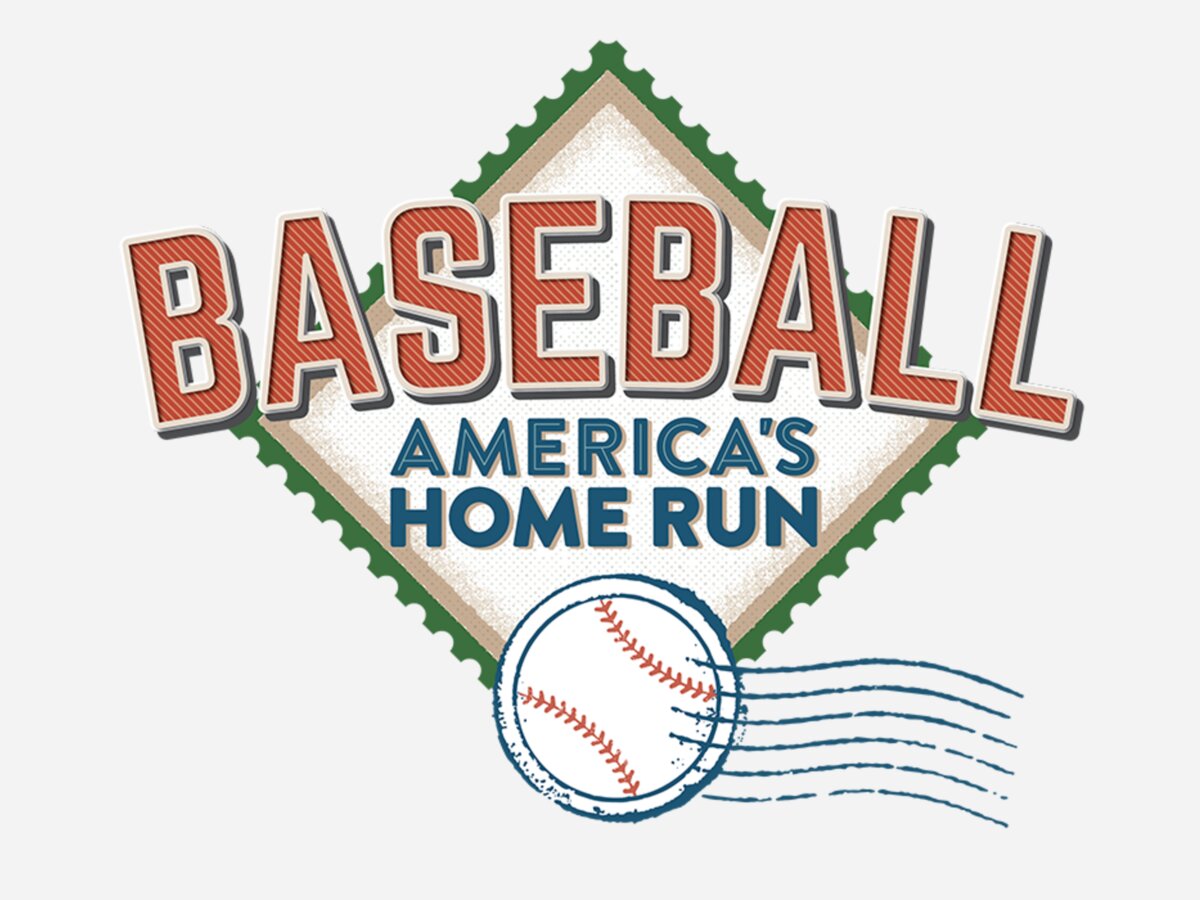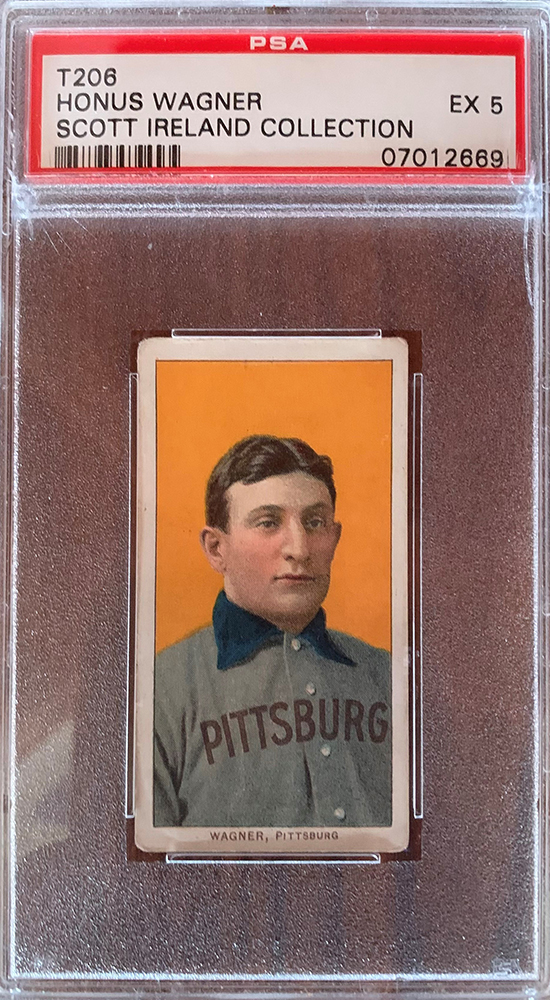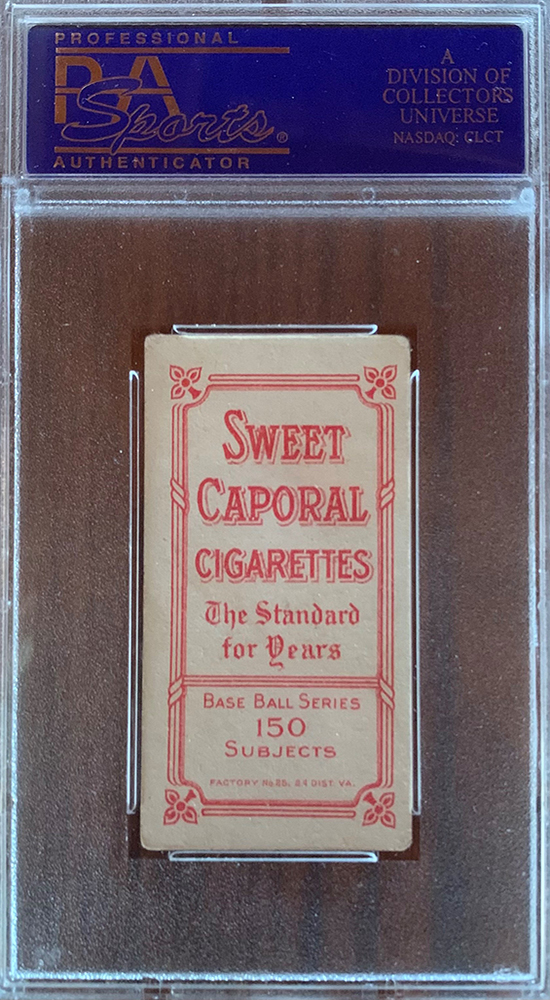Image

T206 Honus Wagner, PSA 5 Baseball Card
Guest blog by Smithsonian-published author Stephen Tsi Chuen Wong who also serves as honorary advisor to the Baseball: America’s Home Run exhibition.
“I don’t want my picture in any cigarettes, but I also don’t want you to lose the 10 dollars, so I’m enclosing my check for that sum.”
—Honus Wagner, in a letter to Pittsburgh sportswriter John Gruber (circa 1908/1909)—
In 1907, the American Tobacco Company (“ATC”), under the leadership of George Washington Hill (who would serve as president of ATC from 1925 until his death in 1946), revived the use of inserts, premiums, and coupons in packs of cigarettes. The move was designed to advertise ATC products, and it did that, but it also ushered in the second great era of American tobacco cards. In 1909, the ATC issued a landmark set of 523 cards (referred to today as “T206” or “white border set”), which are certainly among the most important and popular card sets ever produced. One card, measuring 1 7/16" × 2 ⅝", was inserted into each pack of cigarettes to promote smoking and loyalty to one of the 16 brands advertised on the back of the cards—brands with names like Sweet Caporal, Piedmont, American Beauty, Broad Leat, Carolina Brights, and El Principe De Gales, to name a few. The set was issued during a three-year period from 1909 to 1911, and its cards feature superb color lithographic images of almost every ballplayer of the era.
 Honus Wagner “White Border” baseball card (5), 1909-1911. American Card Catalogue T206 baseball card.
Honus Wagner “White Border” baseball card (5), 1909-1911. American Card Catalogue T206 baseball card. Back of Honus Wagner “White Border” baseball card (5), 1909-1911. American Card Catalogue T206 baseball card.
Back of Honus Wagner “White Border” baseball card (5), 1909-1911. American Card Catalogue T206 baseball card.The American Lithographic Company of New York (“ALC”) produced the images for the set from selected photographs of major-league players. A number of the set's portraits—including those of Honus Wager, Walter Johnson, Frank Chance, Ed Walsh, Joe Tinker, and Addie Joss—are based on the outstanding photographic work of Carl Horner, one of the most renowned baseball studio-portrait master photographers of the early 20th century.
Horner never failed to capture a certain gentleness and refinement in even the hardest of the ballplayers he photographed. Many of the action poses are based on the work of another early-20th-century master photographer, Charles M. Conlon. The lithograph process involved printing in layers, and adding a variety of colors in stages, with high-quality dyes imported from Germany.
The card of Honus Wagner—star shortstop of the Pittsburgh Pirates from 1900 to 1917 and a member of the inaugural class of five at the Hall of Fame—was one of the featured cards in the 1909 set, and it has since achieved a mythical status, transcending the hobby to become an icon of Americana. A T206 Honus Wagner card, graded a 5 on a scale of 1 to 10 by third-party sports grading service, Professional Sports Authenticator (“PSA”), is currently featured in Baseball: America’s Home Run. The card is the second highest graded example known and one of the most important pieces of sports memorabilia in existence.
A partial explanation of the Wagner card's status and allure comes from the well-known legend surrounding the card's origins. As the story goes, Wagner demanded that the ATC stop issuing his card because he did not want to endorse products that encouraged America's youngsters to smoke. For years, however, this account was disputed by naysayers who pointed to Wagner's well-known taste for cigars during his playing days, and his use of chewing tobacco later in his career. Indeed, Wagner's image appears on a circa 1897 cigar-box lid, as well as on an advertising card produced by Henry Reccius, a Louisville cigar merchant and manufacturer of none other than Hans Wagner cigars. During the 1909 World Series, an advertisement for Murad cigarettes ran in Pittsburgh newspapers, featuring an action pose of Wagner along with the baseball-related slogan, “A HIT EVERY TIME.” His image appears again on a box lid for another brand of cigars sold in 1910 and called Hans Wagner-King of the Diamond. On a 1948 bubble gum card produced by Leaf Gum, Inc., and featuring Wagner in his later years, when he was a Pittsburgh Pirates coach, the great player is pictured with a huge wad of chewing tobacco in his mouth and a pack of the stuff in his hands.
Needless to say, there is considerable evidence of both Wagner's affinity for tobacco and his willingness to endorse the product. Such evidence prompted speculation that the real reason his card was pulled from the T206 set was because he wanted more money to cooperate with the ATC—not because he was opposed to smoking.
But an article from The Sporting News, one of baseball's leading publications, lends credence to the hoary legend. According to the article, which ran in the October 24, 1912, edition, Wagner was so opposed to having his picture associated with tobacco products, that he offered money to prevent it. The article states that the ATC offered a Pittsburgh sportswriter named John Gruber a “liberal fee” (10 dollars) to arrange for the images of Wagner and some of his Pirates teammates to be included in the T206 set. But when the sportswriter sought Wager's permission, Wagner kindly refused, and then sent the sportswriter a 10 dollar check to reimburse him for the money he would have earned if he had secured Wagner's cooperation. Gruber refused to cash the check, and was left with an even greater impression of Wagner as a gentleman after this incident. All of the other uses of Wagner's image in service of tobacco products, it seems, were either without his permission, or for products not directly aimed at children.
In addition to symbolizing a significant revival in advertising within the U.S. tobacco industry, T206 cards coincided with a landmark shift in the way the industry was permitted to do business. From 1904 to 1910, companies under the ATC produced 88% of the nation's cigarettes, 75% of its smoking tobacco, and 90% of its snuff. In 1907, the U.S. government began a court battle to dismantle the ATC, claiming it was in violation of the 1890 Sherman Antitrust Act. On May 16, 1911, the U.S. Supreme Court ruled that the ATC was in “restraint of trade and an attempt to monopolize.” ATC was given six months to dissolve. On November 16, 1911, the ATC was split up, with new companies Liggett & Myers and P. Lorillard being granted 28% and 15% of the cigarette business, respectively. ATC retained 37% of the cigarette business.
The ATC’s breakup would put a pause on the golden era of baseball cards that would only be revived three decades later when the Goudey Gum Company out of Boston would usher in the advent of bubble gum cards in the early 1930s.

About the Author
Stephen Wong is managing director, co-head of the Real Estate Group in Asia Ex-Japan and chairman of the Investment Banking Division for Hong Kong at Goldman Sachs. He joined Goldman Sachs in 2005 and received the firm’s prestigious John L. Weinberg Award in 2020. He has published three books with Smithsonian Books, most recently Game Worn: Baseball Treasures from the Game’s Greatest Heroes and Moments (2016) which was nominated for the Casey Award. Wong himself is a life-long collector of rare and significant baseball artifacts. He is one of the world’s foremost authorities on baseball uniforms, game-used bats and other forms of memorabilia and has helped organize baseball-themed exhibitions at the National Museum of American Jewish History, Maltz Museum of Jewish Heritage, and Skirball Cultural Center for “Chasing Dreams: Baseball and Becoming American” (2014 – 2016) and the Museum of the City of New York for “Glory Days: New York Baseball, 1947 – 1957” (2007). Wong is also serving as a senior advisor to The Jackie Robinson Museum in New York and also advises and loans artifacts to the San Francisco Giants. Wong is a member of the Board of Trustees of Hobart and William Smith Colleges where he earned a BA in economics in 1989, and received a Juris Doctorate degree from Stanford Law School in 1992.